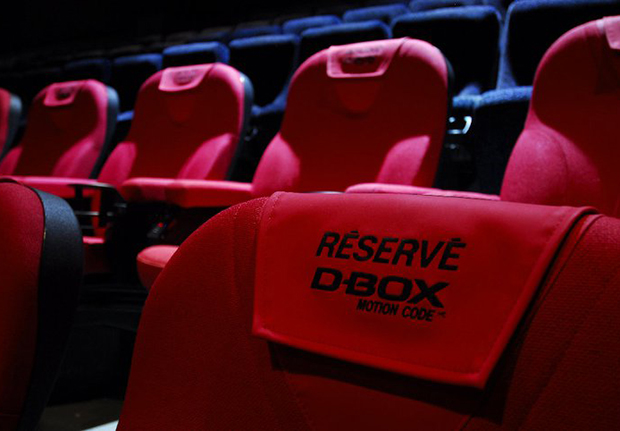In 2009 James Cameron forced 3D on theatres when he released Avatar. Six years later, whiloe 3D maybe still with us….its has definitely lost its lustre. Some people maintain that 3-D movies are a fad poised to soon disappear like they did in the 1950s. Maybe they will. But at D-BOX-equipped theaters across North America, . At D-BOX theaters, 3-D is nothing special—3-D movies seem almost everyday. They have moved on from 3D directly to the 4th dimensions. Here are 4-D movies: at more shake that aerobics at a fat camp, making movies a full-bodied experience.
D-BOX is a “motion-editing” technology designed to make theater seats physically respond to the action in a movie. “Motion effects are specifically programmed for each visual content,” the company’s website explains, “and sent to a motion generating system integrated with either a platform or a seat.” In other words, your seat shakes and tilts in whatever way the movie does. Introduced in 2006 and slowly rolled out as a high-end home-theater peripheral for a few years thereafter, D-BOX’s so-called Motion Code system enjoyed its commercial debut with the premiere of Fast & Furious in 2009. It’s been gradually making its way into multiplexes around the country ever since. Reserved rows of special D-BOX Motion Code seating have popped up in theaters in New York City, Los Angeles, and Chicago.
At $25 per ticket, Motion Code isn’t cheap: A movie for two, plus the customary popcorn and your favorite beverage will run you almost as much as an evening at Morton’s. Many hardtops which have installed D-BOX offers Motion Code try to lure the audiences in with high profile releases, including Avengers: Age of Ultron, San Andreas, and the forthcoming Ant-Man,action, action, action is the rule of the day. 200 feature films have been afforded the D-BOX treatment since its arrival six years ago, running the stylistic gamut from Harry Potter to Paranormal Activity.
IMAX theaters have assigned seating, but you hardly need a ticket number to tell you where the D-BOX seats are: They’re about twice the size of an ordinary chair, sprawled tall and wide and spaced a foot apart from one another down the row. The Motion Code kicks in during the trailers, to entice you during the coming attractions as to let you know the fun you will have paying the same price for a movie as you do as a good porterhouse..It must be an odd sight, with the people seated in the row directly behind the D-Box section are shocked and distracted seeing violent movement and jolting in front of them by their fellow audience members. But soon you’ve settled into the spastics movements, and the feature presentation is ready at last to begin.
In Mad Max‘s one of the first scenes has a crane shot that swoops down from the midair to the ground. D-BOX handled it strikingly: The seat tilted forward gracefully, matching the movement, so that you seemed to be gliding down to earth with the camera. Then, of course, the silence erupts with a car chase—and the motion-editing really kicks in. Pitching, weaving, and rumbling through the action , the Motion Code seats seem, frankly like too much work, more like a theme-park ride than a place to watch a movie. That’s enjoyable and distracting in equal measure. But ideally it should be 8 minutes and duration and not two hours.
On the one hand, it does emphasize all the carnage displayed on screen. It is distracting and frankly takes you away from the most important aspect of the movie,the story.: You’re made so aware of the movement your focus is on the movement and not the movie. So is 4-D the future? not a chance. I just hope Hollywood wakes up and starts telling better stories.
4D, thanks but no thanks.

